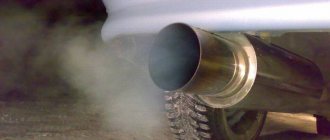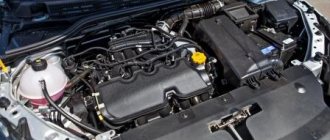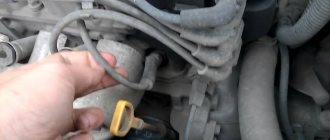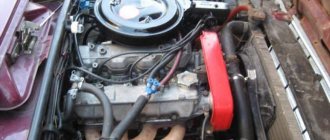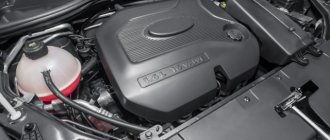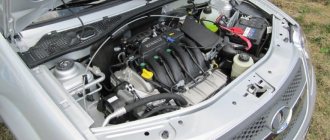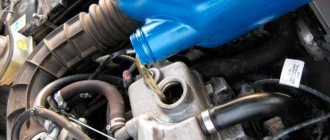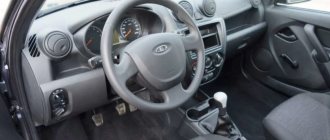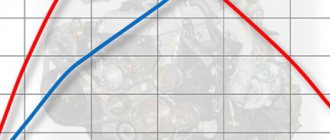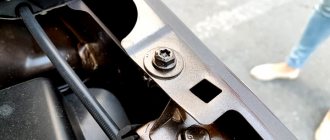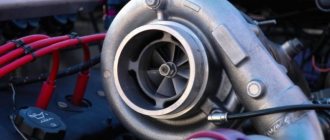- AvtoVAZ
By
admin
—
04.08.2019
583
In the modern world, where the price of fuel is constantly rising, it is necessary to think about how to save on your movement. Giving up the car is not an option, but trying to reduce fuel consumption, in particular on the Lada Granta, can be considered an acceptable option. This is exactly what we will talk about today.
The main reasons for increased fuel consumption.
There is no driver who has never thought about the fuel consumption of his car. Believe me, friends, even owners of expensive supercars also think about fuel consumption. Here's the thing. Most often, increased fuel consumption can be a specific sign of a malfunction in the car. Unfortunately, this search for faults that may have caused increased fuel consumption can be very lengthy and not so simple.
Our online publication 1GAI.RU invites its readers to familiarize themselves with the most common causes of malfunctions in the fuel and other car systems, due to which the car begins to consume more fuel (overconsumption occurs).
Of course, we all know that fuel from the tank flows through a gas line into the combustion chamber of the engine. The amount of fuel supplied to the power unit depends on many factors. Therefore, it is quite natural that a car cannot constantly consume the same amount of fuel. And this is quite normal when a vehicle consumes either more or less amount of gasoline or diesel fuel, depending on its operating conditions. For example, first of all, such consumption depends on how much the vehicle is loaded by weight (empty or with a full interior of passengers and luggage).
Also, secondly, the very distance over which the car moves plays an important role here. In addition, you should not forget about the time of year when exactly the machine is operated. It's no secret that in winter a car consumes much more fuel than in summer. Moreover, all external factors and driving style directly affect not only gasoline engines, but also diesel vehicles.
In most cases, increased fuel consumption is not directly related to any malfunctions in the car. Most often, each driver can directly influence the fuel consumption of his car by first changing his driving style. Among other things, it can be noted that in order to reduce fuel consumption, you must first of all inspect the wheels and some other parts of the car, which, even if in good and serviceable condition, can still be the main reason for excessive fuel consumption by the car.
But it happens differently; it is not uncommon for increased fuel consumption to be associated precisely with possible defects in car components. In this case, it is simply not possible to solve the problem quickly. After all, to do this, you must first install and find this malfunction. Unfortunately, it is quite difficult to find the defect that became the main reason for the increased consumption of gasoline or diesel fuel by a car.
Such reasons for excessive fuel consumption can be both external and internal factors of vehicle breakdown.
Also, as we know, everything in a car is interconnected and the cause of increased fuel consumption can be small defects in several components.
Fuel quality
Not only the level of fuel consumption, but also the reliability of the corresponding components may depend on this aspect. Here, the manufacturer strongly recommends using only 95 gasoline. It is this brand, according to numerous observations of owners and experts, as evidenced by many reviews from owners, that can extend the time until the next required refueling. We should not forget the fact that the primary and important indicator for fuel is its quality, and not the octane number. Similar to the proverb: “Check seven times, and fill once”!
Automatic gearboxes (automatic transmissions) began to be mass-produced in the world since the middle of the last century. Much has changed over time. The cars have become different and the transmission itself is much more advanced. All this time, global auto giants have never ceased to amaze with their new products. Only in Russia was the word “automatic” firmly associated with the name of the great weapons designer. And then it happened. In 2012, the first domestic car of this type rolled off the assembly line - Lada. This event caused a mixed reaction among car enthusiasts.
Some owners spoke with admiration about the excellent characteristics of this car, others expressed dissatisfaction with its shortcomings, the main one of which they considered “gluttony.” The truth, as always, is somewhere nearby. Let's try to objectively understand all the pros and cons of this model, and also find out whether the Lada Granta automatic fuel consumption is really too high? If yes, then for what reasons?
In what cases should you pay attention to fuel consumption?
If you, dear motorists, have noticed that your car has begun to consume more fuel, even by just a few percent, then you should not focus too much attention on this. This is normal for cars. If there is a slight increase in fuel consumption, you can most likely be sure that your car has no malfunctions at these rates.
How to independently determine the cause of increased fuel consumption
Before taking your car to a car service center for diagnostics, to establish the causes of increased fuel consumption, you can independently inspect the car and perhaps you yourself will be able to eliminate the increased consumption of gasoline or diesel fuel by the car.
First, you must initially check the pressure in all tires of the car. The fact is that the most common cause of excessive fuel consumption is incorrect tire pressure. For example, if the tire pressure is insufficient, fuel consumption can increase by almost 30%.
Therefore, remember, friends, you must regularly check the pressure in the wheels and never allow the pressure in them to be more or less than 0.5 bar from that recommended by the manufacturer.
Please remember that incorrect tire pressure reduces or increases rolling resistance, which ultimately affects fuel consumption. The formula here is very simple: -The lower the rolling resistance, the lower the fuel consumption.
Air resistance while the car is moving also plays an important role in this factor.
For example, if you installed a box on the roof of the trunk or placed any weight on it, then the air resistance will immediately increase and the car will begin to consume much more fuel.
Among other things, in open areas and when driving at high speed, the vehicle's fuel consumption may also increase, and all this is due to increased air resistance. For example, such a phenomenon (excessive fuel consumption) is often observed when driving along overpasses and on highways. If a strong headwind blows while the car is moving, the car’s fuel consumption may increase by about 10 - 20%.
In particular, an increase in such consumption may also be due to a dirty air filter. Remember, fellow motorists, that a dirty air filter reduces the flow of oxygen that is needed into the engine. As a result, a non-optimal fuel mixture will enter the engine and the fuel efficiency of the power unit will significantly decrease. Therefore, friends, remember, try to check the condition of the air filter not only at those moments when the engine oil is changed, but also to inspect the filter between scheduled maintenance intervals.
LadaGranta 1.6 (87 hp)
The car is equipped with 1.6-liter engines that develop a power of 87 horsepower and are equipped with a five-speed manual transmission. Torque of 140 Nm helps the Lada Granta accelerate to 180 km/h.
Reviews of fuel consumption Lada Granta 1.6 (87 hp)
- Valery, Sevastopol. Lada Granta 2015, 1.6, manual transmission. I bought it new from the showroom and am pleased with the service and the car, which has a memorable appearance. I deliberately did not take the minimum power, but not the greatest either. As it turned out, the 1.6 engine with 87 “horses” consumes from 6 liters of fuel on the highway to 10 liters in the city.
- Ilya, Tolyatti. For our small family, the Lada Granta came in handy. You can drive around the city, go out of town, and go into nature. The handling is quite comfortable, and the wife is happy with the large trunk. The 1.6 engine (87 mares) requires an average of 8 liters of fuel.
- Konstantin, Moscow. We took the 2012 Lada Granta from the showroom, since it was not a cheap purchase, we hoped for long service, but as it turned out, the car disappointed us. If there were any advantages to it, it all broke down very quickly and required repair. Glad we finally sold. Fuel consumption was 6-9.5 liters.
- Igor, Omsk. Lada Granta, build 2014, 1.6, MT. The car is very good, unpretentious and manageable. During the year of ownership I replaced only consumables. And also economical, which is important, 6-10 liters per hundred is a good indicator.
- Vsevolod, N. Urengoy. I have a 2013 Lada Granta, 1.6 manual. For the first six months I was amazed at this creation of our automobile industry, you feel so good behind the wheel! The suspension smooths out road irregularities well. And the consumption is low: 5.5 on the highway, up to 9 liters in the city.
- Peter, Petersburg. I am the owner of a 2015 Granta with a 1.6 engine of 87 hp, MT. After driving for the first two months, I had a strong impression of it as the best car ever created in our native lands. And you don’t need a lot of gasoline: from 6 liters on a country highway to 9.5 liters in the city.
- Philip, Anthracite. Lada Granta 2013, 1.6, manual transmission. In the first six months I drove 20,000 km, and I can confidently say that the car is very good. Comfortable interior, large trunk, obedient steering wheel and unpretentious repairs. Consumption is very small: on average, about 7 liters.
- Evgeniy, Syktyvkar. I got the 87-horsepower version of the 2014 Lada Granta. Everything in the car suits you, it feels the road well, and the suspension allows you to feel comfort that is unprecedented for domestic cars. The amount of gasoline required is as written in the passport: 6-9 liters.
Mechanical causes of increased fuel consumption
As a rule, all components of the engine and the machine’s attachments are directly responsible for its fuel consumption, since they place a certain load on the engine. Any shaft, roller or belt (etc.) must have free movement and not load the engine itself during operation. Otherwise, during rotation and even slight resistance, you will observe increased fuel consumption by the machine.
Please remember that if something is faulty under the hood of the car, then when you carefully listen to the operation of all systems in the engine compartment, you may hear some kind of grinding, or creaking, or whistling, etc. noises. These sounds will directly indicate to you that some components of the car in the engine compartment are already defective.
In this case, there is a high probability that these car components directly affect the engine load itself, which of course will affect the fuel consumption itself.
The same applies to wheel bearings, which, if worn, will not give the car an optimal ride on the road. Ultimately, the car’s engine will work with increased load, and this will also affect consumption and, naturally, excessive fuel consumption.
The braking system of the car also plays an important role. If it is not working properly, it can significantly affect the fuel consumption itself. For example, brake calipers may not work simultaneously and synchronously, which will ultimately lead to uneven wear of the brake drum pads.
It is also not uncommon for a problem to occur when one or more wheels overheat much more than the others, and all this is due to a delay in opening the caliper itself after braking the car.
So, dear motorists, remember the following: if your car begins to consume more fuel than usual, then do not forget to check the temperature of the wheel rims after braking (of course, after the trip itself). If one wheel is hotter than the other or others, then there is a problem with the brake system in the car and in this particular wheel, which is also a likely reason for the car’s excessive fuel consumption.
But it will be most convenient to check the brakes directly on the lift, by rotating the wheels and by visually inspecting them. If you suddenly find that one of the brake pads touches the brake disc when the wheel rotates freely, or sticks out too close from the caliper, then you will need a more detailed diagnosis of the brake caliper.
Lada Granta engines 16 valves
This engine is also equipped with a lightweight piston group manufactured by Federal Mogul and a belt with an automatic tensioner from Gates. It is distinguished by a 16-valve head with a pair of camshafts and hydraulic compensators, due to which its power is significantly higher.
All the problems of its predecessors apply to this unit in full. The engine often suffers from lubricant leaks, tripping, floating speed, sensor glitches and valve burnout. Plus, you can add hydraulic compensators that are very demanding on oil quality.
Hatchback before restyling 2015 - 2019
| 1.6 l 21126 MKP5 | 1.6 l 21126 automatic transmission4 | |
| Type | injector | injector |
| Fuel | gasoline AI-92 | gasoline AI-92 |
| Location | transverse | transverse |
| Cylinders | 4 in a row | 4 in a row |
| valves | 16 | 16 |
| Working volume | 1596 cm³ | 1596 cm³ |
| Power | 98 hp | 98 hp |
| Torque | 145 Nm | 145 Nm |
| Acceleration to 100 km/h | 11.2 s | 13.3 s |
| Speed (max) | 182 km/h | 173 km/h |
| Ecological Class | Euro 5 | Euro 5 |
| Consumption city | 8.8 l | 9.9 l |
| Flow track | 5.6 l | 6.1 l |
| Mixed flow | 6.8 l | 7.2 l |
All technical characteristics of the engine are described on the Motor VAZ portal
The updated engine received an adjustable intake tract with dampers in the receiver channels. Also here, the mass air flow sensor gave way to a combination of absolute pressure and air temperature sensors, thanks to which the frequent problem of floating speed at idle has finally gone away.
The reliability of the new unit has increased, although it is not flawless. The thermostat also often fails, the injectors become clogged, and the ignition system malfunctions. But the main threat is the water pump, because of the wedge of which the timing belt breaks and the pistons meet the valves. Update: In July 2021, the manufacturer equipped this engine with plugless pistons.
Hatchback before restyling 2015 - 2019
| 1.6 l 21127 MKP5 | 1.6 l 21127 AMT5 | |
| Type | injector | injector |
| Fuel | gasoline AI-92 | gasoline AI-92 |
| Location | transverse | transverse |
| Cylinders | 4 in a row | 4 in a row |
| valves | 16 | 16 |
| Working volume | 1596 cm³ | 1596 cm³ |
| Power | 106 hp | 106 hp |
| Torque | 148 Nm | 148 Nm |
| Acceleration to 100 km/h | 10.9 s | 12.3 s |
| Speed (max) | 183 km/h | 180 km/h |
| Ecological Class | Euro 5 | Euro 5 |
| Consumption city | 8.6 l | 9.0 l |
| Flow track | 5.6 l | 5.2 l |
| Mixed flow | 6.5 l | 6.5 l |
All differences from its predecessors are described in one of the blogs on Drive 2
Source
Defects in vehicle attachments and auxiliary equipment can lead to excessive fuel consumption
Malfunction and improper operation of auxiliary equipment installed under the hood of the car can lead to an increase (increase) in fuel consumption. For example, fuel consumption can increase significantly if the same air conditioning compressor malfunctions.
All motorists know that when the air conditioning is turned off, the car consumes very little fuel. But as soon as we turn on the cabin cooling, this fuel consumption immediately increases, from approximately 0.5 to 2.5 liters per 100 km.
This is primarily due to the fact that when the interior cooling is turned on, the air conditioning compressor, which is connected by a clutch and a belt drive to the engine, immediately starts working. As a result, the compressor begins to put a significant load on the engine, and the higher the temperature outside, the more power the air conditioner itself requires to cool the air inside the car.
How to calculate a car's fuel consumption
The average fuel consumption is calculated by the on-board computer based on the driving distance and the average speed of the vehicle. Modern cars have different graphic and digital displays of fuel consumption per trip l/100 km (liters per 100 km), instantaneous fuel consumption l/h (liters per hour), gas pedal position in % - the so-called acceleration. Manual transmissions are equipped with gear shift indicators that recommend when to shift in order to save fuel. Also, almost all on-board computers have an indicator of how many kilometers of gasoline or diesel are left in the tank. This is convenient for calculating the distance to the desired gas stations.
